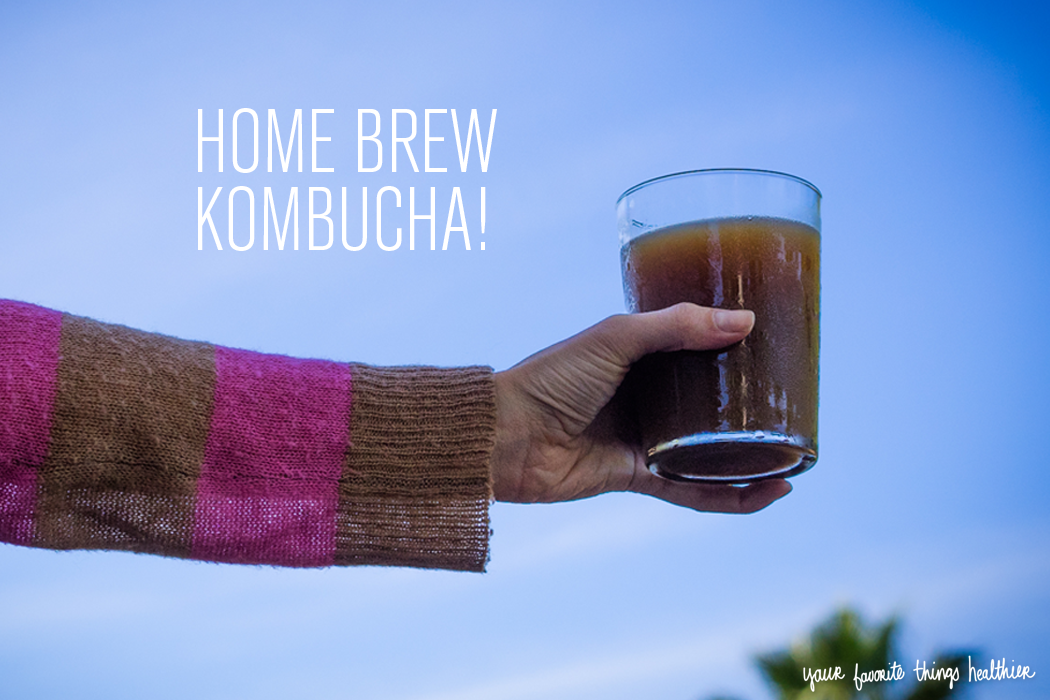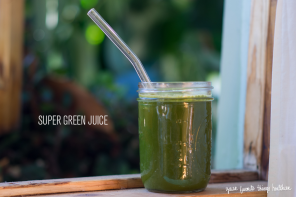How Kombucha Making Discovered Us
We met the nicest woman in a health store in Sedona while looking for supplements. After an hour long chat she asked if kombucha was part of our diet. I’ve tried it before but wasn’t in love with the stuff. After a little coaxing she convinced us to give it another go. And we’re glad we did!
She offered to meet us the next day when her home-brew batch of kombucha was ready and offered to give us one of her SCOBY’s. A scob-wha? After a little google searching we found out it stands for: a symbiotic colony of bacteria and yeast. Cool! We met her the next day in an Office Depot parking lot (really!) and she gave us a list of instructions and a starter SCOBY to bring back to California. Hippieville here we come!
 Healthy Gut
Healthy Gut
I’ve been on a mission lately to heal my gut. After some research I discovered kombucha is a great source of probiotics. What is kombucha exactly and how could it help my gut, I wondered? Kombucha is a fermented black or green sweet tea that is used as a functional food. It contains b-vitamins, enzymes, probiotics and acid that aid in digestion, cleansing and detoxing, and supporting your immune system.
If you know a friend who brews their own kombucha ask if you can have one of their SCOBY’s. I promise. If they’re brewing kombucha they’ll have a SCOBY hotel in there fridge by now and will be looking for a good home asap. That’s because each time you make kombucha, you start with a single SCOBY, but by in the process of making the new batch, a second SCOBY grows. Don’t worry, you can store them happily in the fridge. If you don’t know anyone with an extra SCOBY hibernating in their fridge, you can buy a kombucha starter kit (here and here) to get going.
Below is our new friend’s recipe. We hope you enjoy it as much as we do!
You will need:
- Starter culture, or SCOBY
- Kombucha starter (the liquid the scoby was sitting in)
- 1 ounce of loose tea
- a jar, preferably as large as one gallon (food-grade plastic containers are acceptable as well)
- a clean, lint-free, tightly woven cloth, like a piece of a bedsheet or dish towel, to put over the top of the jar and a rubberband to hold it onto the jar.
- organic sugar (one cup per gallon of kombucha you will be making), feel free to substitute the sugar for raw organic honey or organic coconut sugar
Directions to make one gallon of kombucha:
- Bring 1/2 gallon of water to a boil. Remove from heat.
- Add one cup of sugar, stir well until sugar is dissolved
- Add one ounce of loose tea, as well as any herbs, flowers or dried fruits that you want the kombucha to taste like
- Cover. Allow to steep for one hour
- Strain into a very clean one-gallon jar
- Add COLD water to fill the container up to about three or four inches from the top
- With the addition of the cold water the temperature of the tea should now be much lower. The SCOBY is a living organism and will die if placed in hot tea. With the cold water added it should be fine, but if you are concerned, then cover your tea and let it cool to near room temperature.
- Add your SCOBY to the tea, as well as the liquid starter kombucha. You need at least one cup of starter kombucha per gallon, and you should have that much from your starter SCOBY.
- This should raise the level of liquid in your jar almost to the very top.
- Place your tightly-woven cloth over the top of the jar. Use a rubberband to hold it on.
- Put the jar in a quiet area, away from windows, where it’s out of direct light and won’t get jostled.
Notes
- The ideal temperature is 70-80 degrees. It shouldn’t be anywhere it will get hotter or colder than that.
- If you start to see fruit flies hanging out by your kombucha, don’t worry. The best thing to do is get a little fan that you can aim right at the top of the jar. Fruit flies can’t handle a breeze and blowing air on your kombucha is not a problem.
- Fermentation will take 7 to 14 days.
- You can sample your kombucha at any time. Take the cloth off and use a clean ladle to gently mix it up and then pull some beverage out to try.
- It’s done when you like the taste. There should be a mix of sweet and sour. A little vinegar flavor is common – that’s the acetic acid resulting in fermentation.
- When you’re happy with your batch, wash your hands well and place the SCOBY in another container, along with some kombucha for it to rest in (this kombucha will also be your starter kombucha for your next batch)
- If you bottle your kombucha, let it sit out at room temperature for 2 or 3 days and it will carbonate in the bottle. Be careful, if it sits out for a week or more it could over-carbonate and will fizz out all over when you open it.
- Keep it in the fridge otherwise.
- It is best served cold and is lovely over ice.
Be Careful
If you are on any medications or are pregnant/nursing please consult a doctor before consuming any kombucha. There can be some alcohol content from the fermentation process.
Not sure you want to brew your own? Try out a few different brands and make the decision for yourself 🙂
If you add any flavors, do it at the end. Ginger is great. So is mint. We’ve even tried it with smoke-infused tea leaves. Delicious!
Please leave a comment if you have a favorite add-in or a trick we missed.





